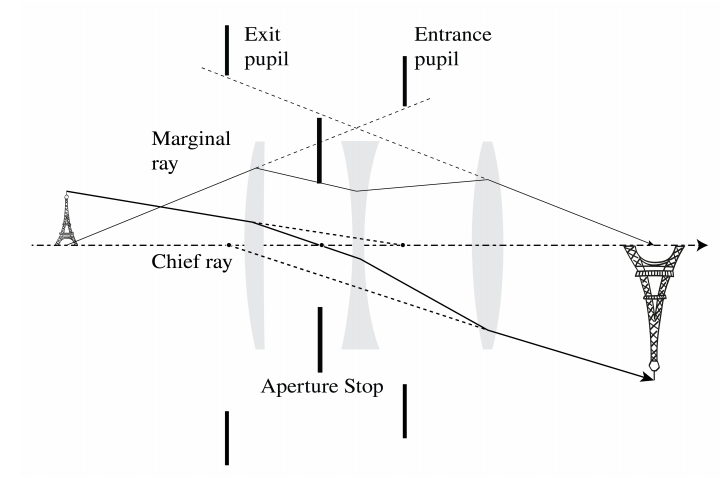2.6: Gaussian Geometrical Optics
( \newcommand{\kernel}{\mathrm{null}\,}\)
We have seen above that by using lenses or mirrors which have surfaces that are conic sections we can perfectly image a certain pair of points, but for other points the image is in general not perfect. The imperfections are caused by rays that make larger angles with the optical axis, i.e. with the symmetry axis of the system. Rays for which these angles are small are called paraxial rays. Because for paraxial rays the angles of incidence and transmission at the surfaces of the lenses are small, the sine of the angles in Snell’s Law are replaced by the angles themselves:
niθi=ntθt.
This approximation greatly simplifies the calculations. When only paraxial rays are considered, one may replace any refracting surface by a sphere with the same curvature at its vertex. For paraxial rays, errors caused by replacing the general surface by a sphere are of second order and hence insignificant. Spherical surfaces are not only more simple in the derivations but they are also much easier to manufacture. Hence in the optical industry spherical surfaces are used a lot. To reduce imaging errors caused by non-paraxial rays one applies two strategies:
- adding more spherical surfaces
- replacing one of the spherical surfaces (typically the last before image space) by a non-sphere.
In Gaussian geometrical optics only paraxial rays and spherical surfaces are considered. In Gaussian geometrical optics every point has a perfect image.
2.5.1 Gaussian Imaging by a Single Spherical Surface
We will first show that within Gaussian optics a single spherical surface between two media with refractive indices n1 < n2 images all points perfectly (Figure 2.6.1). The sphere has radius R and centre C which is inside medium 2. We consider a point object S to the left of the surface. We draw a ray from S perpendicular to the surface. The point of intersection is V. Since for this ray the angle of incidence with the local normal on the surface vanishes, the ray continues into the second medium without refraction and passes through the centre C of the sphere. Next we draw a ray that hits the spherical surface in some point A and draw the refracted ray in medium 2 using Snell’s law in the paraxial form (2.6.1) (note that the angles of incidence and transmission must be measured with respect to the local normal at A, i.e. with respect to CA). We assume that this ray intersects the first ray in point P. We will show that within the approximation of Gaussian geometrical optics, all rays from S pass through P. Furthermore, with respect to a coordinate system (y, z) with origin at V , the z-axis pointing from V to C and the y-axis positive upwards as shown in Figure 2.6.1, we have:
−n1s0+n2si=n2−n1R.
where s0 and si are the z-coordinates of S and P, respectively (hence s0 < 0 and si > 0 in Figure 2.6.1).
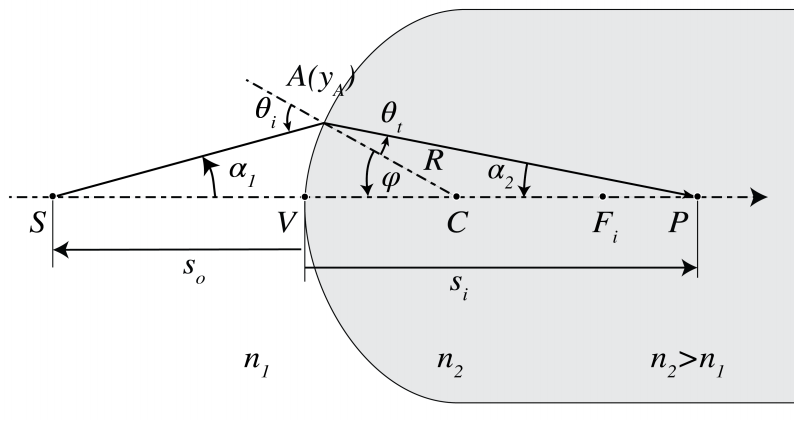
Proof.
(Note: the proof is not part of the exam). It suffices to show that P is independent of the ray, i.e. of A. We will do this by expressing si into so and showing that the result is independent of A. Let α1 and α2 be the angles of the rays SA and AP with the z-axis as shown in Figure 2.6.1. Let θi be the angle of incidence of ray SA with the local normal CA on the surface and θt be the angle of refraction. By considering the angles in ∆ SCA we find
θi=α1+ϕ.
Similarly, from ∆ CPA we find
θt=−α2+ϕ.
By substitution into the paraxial version of Snell’s Law (2.6.1), we obtain
n1α1+n2α2=(n2−n1)ϕ.
Let yA and zA be the coordinates of point A. Since so < 0 and si > 0 we have
α1≈tan(α1)=yAzA−so,α2≈tan(α2)=yAsi−zA.
Furthermore,
ϕ≈sinϕ≈yAR.
which is small for paraxial rays. Hence,
zA=R−Rcosϕ=R−R(1−ϕ22)=R2ϕ2≈0,
because it is second order in yA and therefore is neglected in the paraxial approximation. Then, (2.6.6 becomes
α1=−yAso,α2=yAsi.
By substituting (2.6.9 and (2.6.7 into (2.6.5 we find −(n1/so)yA + (n2/zi)yA = [(n2 − n1)/R]yA, or −n1/so+n2/zi=(n2 − n1)/R,which is Eq. (2.6.2. It implies that si, and hence P, is independent of yA, i.e. of the ray chosen. Therefore, P is a perfect image within the approximation of Gaussian geometrical optics.
When si → ∞, the ray after refraction is parallel to the z-axis and we get so → −n1R/(n2 − n1). The object point for which the rays in the medium 2 are parallel to the z-axis is called the first focal point or object focal point Fo, Its z-coordinate is:
fo=−n1Rn2−n1.
In spite of the fact that this is a coordinate and hence has a sign, it is also called the front focal length or object focal length.
When so → −∞, the incident ray is parallel to the z-axis in medium 1 and the corresponding image point Fi is called the second focal point or image focal point. Its z-coordinate is given by:
fi=n2Rn2−n1,
and it is also referred to as the second focal length or image focal length. With (2.6.11) and (2.6.10), (2.6.2) can be rewritten as:
−n1so+n2si=n2fi=−n1fo.
By adopting the sign convention listed in Table 2.6.1 below, it turns out that (2.6.2) holds generally. For example, when point S is between the front focal point and the vertex V so that fo < so < 0, the rays from S are so strongly diverging that the refraction is insufficient to obtain an image point in medium 2. Instead there is a diverging ray bundle in medium 2 which for an observer in medium 2 seems to come from a point P in medium 1 with z-coordinate si , hence si < 0, in agreement with the fact that P is now to the left of V. Point P is called a virtual image because it does not correspond to an actual concentration of light energy in space. When si > 0 there is a concentration of light energy in P which therefore is then called a real image.
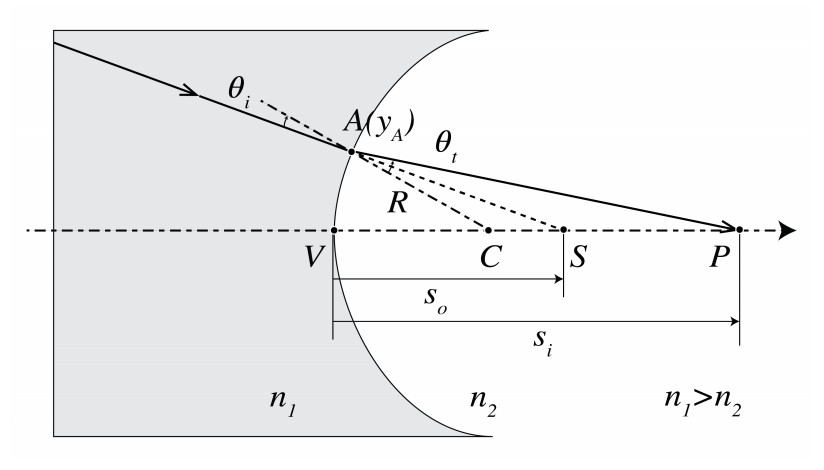
| quantity | positive | negative |
|---|---|---|
| so, fo, si, fi | corresponding point is to the right of vertex | corresponding point is to left of vertex |
| R | centre of curvature right of vertex | centre of curvature left of vertex |
| α (astute ray angle) | if counter clockwise rotation over α makes ray parallel to z-axis | if clockwise rotation over α makes ray parallel to z-axis |
| Refr. index n ambient medium of mirror | before reflection | after reflection |
If n1>n2 or R<0 (i.e. the surface is concave when seen from the left of the vertex), the right-hand side of (2.6.2) is negative:
n2−n1R<0.
Light rays incident from the left are then refracted away from the z-axis and incident rays that are parallel to the z-axis are refracted such that they never intersect the z-axis in medium 2. Instead, they seem to be emitted by a point in medium 1. As illustrated in Figure 2.6.2, the second focal point is thus virtual with negative focal length given by:
fi=n2Rn2−n1<0.
Furthermore, fo > 0 and an incident ray that after refraction is parallel to the z-axis in medium 2 seems for an observer in medium 1 to converge to a point in medium 2. Hence the first focal point is virtual as well: fo > 0. When (2.6.12) holds, for all object points S in front of the lens (so < 0), the image point is always virtual. In fact, si as given by (2.6.2) is then always negative.
2.5.2 Ray Vectors and Ray Matrices
In geometrical optics it is convenient to use ray vectors and ray matrices. In any plane perpendicular to the z-axis, a ray is determined by the y-coordinate of the point of intersection of the ray with the plane and the acute angle α of the ray with the z-axis. Here y > 0 when the intersection point is above the z-axis and y < 0 otherwise. We define the ray vector
\dbinom{nα}{y}, \nonumber
where n is the local refractive index. The definition with the refractive index as factor in the first element of the ray vector turns out to be convenient. The acute angle α has sign according to the convention in Table \PageIndex{1}.
The ray vectors of a ray in any two planes z = z1, z = z2, with z2 > z1, are related by a so-called ray matrix:
\dbinom{n_{2}α_{2}}{y_{2}}=M\dbinom{n_{1}α_{1}}{y_{1}}. \nonumber
where
M=\begin{pmatrix} A & B \\ C & D \end{pmatrix}. \nonumber
The elements of matrix M depend on the optical components and materials between the planes z = z1 and z = z2.
As an example consider the ray matrix that relates a ray vector in the plane immediately before the spherical surface in Figure \PageIndex{2} to the corresponding ray vector in the plane immediately behind that surface. Using (\PageIndex{5}) and (\PageIndex{7}) it follows
n_{1}α_{1}-n_{2}α_{2}=\dfrac{(n_{2}-n_{1})y_{1}}{R}, \nonumber
where we have replaced α2 by −α2 in (\PageIndex{5}), because according to the sign convention, the angle α2 in Figure \PageIndex{1} should be taken negative. Because furthermore y2 = y1, we conclude
\dbinom{n_{2}α_{2}}{y_{2}}=\dbinom{n_{1}α_{1}-\dfrac{(n_{2}-n_{1})y_{1}}{R}}{y_{1}}=\begin{pmatrix} 1 & -P \\ 0 & 1 \end{pmatrix}\dbinom{n_{1}α_{1}}{y_{1}},spherical\space surface, \nonumber
where
P=\dfrac{n_{2}-n_{1}}{R}, \nonumber
is called the power of the surface.
For a spherical mirror with radius of curvature R, we see that
α_{1}=θ_{i} − ϕ, \nonumber
α_{2}=-θ_{r} − ϕ, \nonumber
where we take the sign convention for the angles into account. Because θr = θi we find
α_{2}=-α_{1}+2ϕ=-α_{1}+2\dfrac{y_{1}}{R}, \nonumber
where we used (\PageIndex{7}) with yA = y1. As mentioned in Table \PageIndex{1}, the refractive index after reflection is to be chosen negative. This means that for rays that propagate from right to left, the refractive index in the ray vector should be chosen negative. Hence,
n_{2}α_{2}=-n_{1}α_{2}= n_{1}α_{1} -2n_{1}\dfrac{y_{1}}{R}. \nonumber
Then
\dbinom{n_{2}α_{2}}{y_{2}}=\begin{pmatrix} 1 & -P \\ 0 & 1 \end{pmatrix}\dbinom{n_{1}α_{1}}{y_{1}},spherical\space reflector, \nonumber
where
P=\dfrac{2n_{1}}{R} \nonumber
is the power of the mirror. We conclude that the ray matrix for reflection by a spherical mirror is the same as that for refraction by a spherical surface, provided that n2 is replaced by −n1. When a ray is propagating from the right to the left, the refractive index of all media and interfaces through which the ray propagates, and at which it is being refracted, should have negative refractive index. After the ray has been reflected a second time, due to which it propagates again from left to right, all refractive indices should again be positive. In this way the matrix method can be applied to optical systems consisting of both refracting elements, such as lenses, and reflecting elements.
Finally we consider the case that between the two planes there is homogeneous material with refractive index n. In that case α2 = α1 and y2 = y1 + α1(z2 − z1), hence
M=\begin{pmatrix} 1 & 0 \\ \dfrac{z_{2}-z_{1}}{n} & 1 \end{pmatrix},homogeneous\space space. \nonumber
For two planes between which there are a number of optical components, possibly separated by regions with homogeneous material (e.g. air), the ray matrix can be obtained by multiplying the matrices of the individual components and of the homogeneous regions. The order of the multiplication of the matrices is such that the right-most matrix corresponds to the first component that is encountered while propagating, and so on.
It should be remarked that the rays considered in the ray matrix approach stay in the same plane, namely the plane through the ray and the z-axis. These rays are called meridional rays. By considering only meridional rays, the imaging by optical systems is restricted to two dimensions. Non-meridional rays are called skew rays. Skew rays do not pass through the optical axis and they are not considered in the paraxial theory.
2.5.3 The Lens Matrix
We apply ray matrices to a lens. Figure \PageIndex{4} shows a lens with two spherical surfaces. The refractive index of the lens is nl and that of the ambient medium is nm and the distance between the vertices is d. We will first derive the matrix which maps the ray vector in the plane immediately in front of the lens to that in the plane immediately behind the lens. Let
\dbinom{n_{m}α_{1}}{y_{1}}and\dbinom{n_{m}α_{2}}{y_{2}} \nonumber
be two vectors in the two planes which correspond to the same ray. The ray is first refracted by the spherical surface with radius R1 and centre C1. Using (\PageIndex{25}) and (\PageIndex{20}) it follows that the matrix between the ray vectors just before and just behind the spherical surface with radius R1 and centre C1 is given by
M_{1}=\begin{pmatrix} 1 & -\dfrac{ n_{l} - n_{m} }{R_{1}} \\ 0 & 1 \end{pmatrix} \nonumber
The ray propagates then over the distance d through the material of which the lens is made. The matrix that maps ray vectors from the plane inside the lens immediately behind the left spherical surface to a ray vector in the plane immediately before the right spherical surface follows from (\PageIndex{27}):
M=\begin{pmatrix} 1 & 0 \\ \dfrac{d}{n_{l}} & 1 \end{pmatrix}. \nonumber
Finally, the matrix that maps ray vectors from the plane in the lens immediately before the second spherical surface to vectors in the plane immediately behind it is
M_{1}=\begin{pmatrix} 1 & -\dfrac{ n_{m} - n_{l} }{R_{2}} \\ 0 & 1 \end{pmatrix}. \nonumber
Hence the matrix that maps ray vectors in the plane immediately before the lens to ray vectors in the plane immediately behind the lens is given by the matrix product:
M=M_{3}M_{2}M_{1}=\begin{pmatrix} 1-\dfrac{d}{n_{l}}P_{2} & -P_{1}-P_{2}+\dfrac{d}{n_{l}}P_{1}P_{2} \\ \dfrac{d}{n_{l}} & 1-\dfrac{d}{n_{l}}P_{1} \end{pmatrix},lens, \nonumber
where
P_{1}=\dfrac{ n_{l} - n_{m} }{R_{1}},P_{2}=\dfrac{ n_{m} - n_{l} }{R_{2}}. \nonumber
The quantity
P=P_{1}+P_{2}-\dfrac{d}{n_{l}}P_{1}P_{2} \nonumber
is called the power of the lens. It has dimension 1/length and is given in diopter (D), where 1 D = m−1. The power can be positive and negative. The z-axis is the axis of symmetry and is called the optical axis. The space to the left of the lens is called the object space and that to the right of the lens is called the image space.
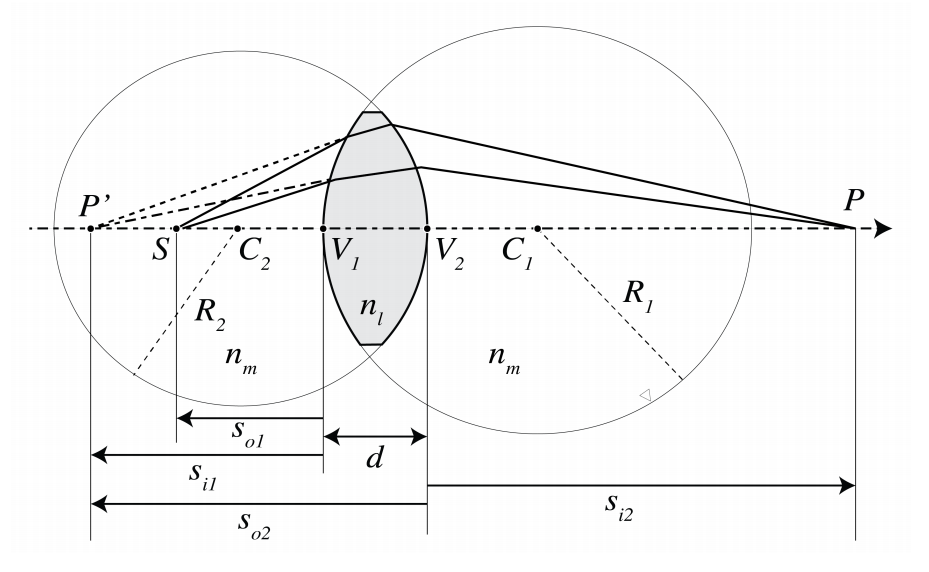
2.5.4 Focusing with a Thin Lens
For a thin lens the vertices V1 and V2 coincide and d = 0, hence (\PageIndex{34}) becomes
M=\begin{pmatrix} 1 & -P \\ 0 & 1 \end{pmatrix},thin\space lens, \nonumber
where P = P1 + P2, with P1 and P2 given by (\PageIndex{35}). The origin of the coordinate system is chosen in the common vertex V1 = V2. For a ray emerging in image space at height y2 and parallel to the optical axis: α2 = 0, we have y1 = y2 and
n_{m} α _{1}=P_{y}. \nonumber
If the power is positive: P > 0, the angle α1 has the same sign as y1, which implies that the ray in object space has intersected the optical axis in a point Fo with z-coordinate: z = fo satisfying
\dfrac{1}{f_{o}}=\dfrac{α _{1}}{y _{1}} = \dfrac{n_{m}}{P}=\dfrac{n_{l}-n_{m}}{n_{m}}(\dfrac{1}{R_{1}}-\dfrac{1}{R_{2}}). \nonumber
The point Fo is called the first focal point or object focal point.
Similarly, by considering a ray in medium 1 which is parallel to the optical axis (α1 = 0) and at height y1, we get nmα2 = −P y1 and y2 = y1. Hence, when P > 0, the angle α2 of the ray has sign opposite to y2 and therefore the ray in image space is bent back to the optical axis, yielding a second focal point or image focal point Fi. Its z-coordinate fi satisfies:
\dfrac{1}{f_{i}}=-\dfrac{α _{2}}{y _{2}} = -\dfrac{n_{m}}{P}=-\dfrac{1}{f_{o}}. \nonumber
When the power P of the lens is positive, fi = −fo > 0, which means that the first and second focal points are in the object and image space, respectively. A lens with positive power is called convergent or positive.
A lens with negative power is called divergent and has fi = −fo < 0. Then incident rays parallel to the optical axis are refracted away from the optical axis and seem to come from a point in front of the lens with z-coordinate fi < 0. Hence the second focal point does not correspond to a location where there is actual concentration of light intensity and hence it is virtual. The first focal point is a virtual object point, because only for a bundle of incident rays that are converging to a certain point behind the lens, the negative refraction can give a bundle of rays that are all parallel to the optical axis.
With the results obtained for the focal coordinates we can rewrite the lens matrix of a thin lens alternatively as
M=\begin{pmatrix} 1 & -\dfrac{n_{m}}{f_{i}} \\ 0 & 1 \end{pmatrix},thin\space lens. \nonumber
2.5.5 Imaging with a Thin Lens
We first consider the general ray matrix (\PageIndex{16}), (\PageIndex{17}) between two planes z = z1 and z = z2 and ask the following question: what are the properties of the ray matrix such that the two planes are images of each other, or (as this is also called) are each other’s conjugate? Clearly for these planes to be each other’s image, we should have that for every point coordinate y1 in the plane z = z1, there is a point with coordinate y2 in the plane z = z2 such that any ray through (y1, z1) (within some cone of rays) will pass through point (y2, z2). Hence for any angle α1 (in some interval of angles) there is an angle α2 such that (\PageIndex{16}) is valid. This means that for any y1 there is a y2 such that for all angles α1:
y _{2}=Cn_{1}α _{1}+Dy _{1}, \nonumber
This requires that
C = 0, condition\space for\space imaging. \nonumber
The ratio of y2 and y1 gives the magnification. Hence
\dfrac{y _{2}}{y _{1}}=D, \nonumber
is the magnification of the image (this quantity has sign).
To determine the image of a point by a thin lens we first derive the ray matrix between the planes z = z1 < 0 and z = z2 > 0 with a thin lens in between with vertex at the origin. This matrix is the product of the matrix for propagating from z = z1 to the plane immediately in front of the lens, the matrix of the thin lens and the matrix for propagation from the plane immediately behind the lens to the plane z = z2:
M=\begin{pmatrix} 1 & 0 \\ \dfrac{z _{2}}{n _{m}} & 1 \end{pmatrix}\begin{pmatrix} 1 & -\dfrac{n _{m}}{f_{i}} \\ 0 & 1 \end{pmatrix}\begin{pmatrix} 1 & 0 \\ -\dfrac{z _{1}}{n _{m}} & 1 \end{pmatrix}=\begin{pmatrix} 1+\dfrac{z _{1}}{f_{i}} & -\dfrac{n _{m}}{f_{i}} \\ -\dfrac{z _{1}}{n _{m}}+\dfrac{z _{2}}{n _{m}}+\dfrac{z _{1}z _{2}}{n _{m}f_{i}} & 1-\dfrac{z _{2}}{f _{i}} \end{pmatrix} \nonumber
The imaging condition (\PageIndex{41}) implies:
-\dfrac{1}{s _{o}}+\dfrac{1}{s _{i}}=\dfrac{1}{f _{i}},Lensmaker's\space Formula. \nonumber
where we have written so = z1 and si = z2 for the z-coordinates of the object and the image. Because for the thin lens matrix (\PageIndex{43}): D = 1− z2/fi , it follows by using (\PageIndex{44}) that the magnification (\PageIndex{42}) is given by
M=\dfrac{y _{i}}{y _{o}}=1-\dfrac{s _{i}}{f _{i}}=\dfrac{s _{i}}{s _{o}}, \nonumber
where we have written now yo and yi instead of y1 and y2, respectively.
For a positive lens: fi > 0 and hence (\PageIndex{44}) implies that si > 0 provided |so| < fi = |fo|, which means that the image by a convergent lens is real if the object is further from the lens than the first focal point Fo. The case so > 0 corresponds to a virtual object, i.e. to the case of a converging bundle of incident rays, which for an observer in object space seems to converge to a point at distance so behind the lens. A convergent lens (fi > 0) will then make an image between the lens and the second focal point. In contrast, a diverging lens (fi < 0) can turn the incident-converging bundle into a real image only if the virtual object point is between the lens and the focal point. If the virtual object point has larger distance to the lens, the convergence of the incident bundle is too weak and the diverging lens then refracts this bundle into a diverging bundle of rays with vertex at the virtual image point in front of the lens (si < 0).
One can also construct the image with a ruler. Consider imaging a finite object S1S2 as shown in Figure \PageIndex{4}. Let yo be the y-coordinate of S2. We have yo > 0 when the object is above the optical axis. Draw the ray through the focal point Fo in object space and the ray through the centre V of the lens. The first ray becomes parallel in image space. The latter intersects both surfaces of the lens almost in their (almost coinciding) vertices and therefore the refraction is opposite at both surfaces and the ray exits the lens parallel to its direction of incidence. Furthermore, its lateral displacement can be neglected because the lens is thin. Hence, the ray through the centre of the lens is not refracted. The intersection in image space of the two rays gives the location of the image point P2 of S2. The image is real if the intersection occurs in image space and is virtual otherwise. For the case of a convergent lens with a real object with yo > 0 as shown in Figure \PageIndex{4}, it follows from the similar triangles ∆ AVFi and ∆ P2P1Fi that
\dfrac{y _{o}}{|y _{i}|}=\dfrac{f _{i}}{s _{i}-f _{i}}, \nonumber
where we used |fo| = fi. From the similar triangles ∆ S2S1Fo and ∆ BVFo:
\dfrac{|y _{i}|}{y _{o}}=\dfrac{f _{i}}{f _{o}-s _{o}}. \nonumber
(the absolute value of yi is taken because according to our sign convention yi in Figure \PageIndex{4} is negative whereas (\PageIndex{44}) is a ratio of lengths). By multiplying these two equations we get the Newtonian form of the lens equation:
x _{o}x _{i}=-f _{i}^2=-f _{o}^2, \nonumber
where xo and xi are the z-coordinates of the object and image relative to those of the first and second focal point, respectively:
x _{o}=s _{o}-f _{o},x _{i}=s _{i}-f _{i}. \nonumber
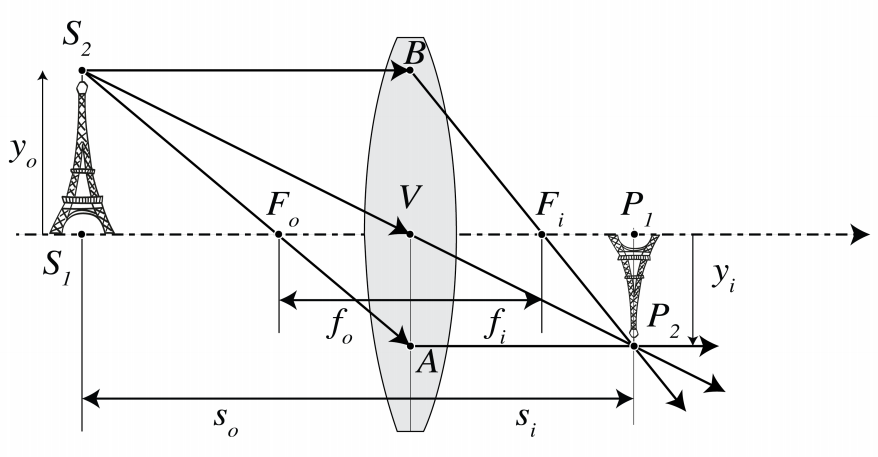
Hence xo is negative if the object is to the left of Fo and xi is positive if the image is to the right of Fi.
The transverse magnification is
M=\dfrac{y _{i}}{y _{o}}=\dfrac{s _{i}}{s _{o}}= -\dfrac{x _{i}}{f _{i}} , \nonumber
where the second identity follows from considering the similar triangles ∆P2P1Fi and ∆AVFi in Figure \PageIndex{4}. A positive M means that the image is erect, a negative M means that the image is inverted (as is always the case for a single lens).
All equations are also valid for a thin negative lenses and for virtual objects and images. Some examples of real and virtual object and image points for a positive and a negative lens are shown in Figs. \PageIndex{5} and \PageIndex{6}.
2.5.6 Two Thin Lenses
The imaging by two thin lenses L1 and L2 can easily be obtained by construction. We simply construct the image obtained by the first lens as if the second lens were not present and use this image as (possibly virtual) object for the second lens. In Figure \PageIndex{7} an example is shown where the distance between the lenses is larger than the sum of their focal lengths. First the image P' of S is constructed as obtained by L1 as if L2 were not present. We construct the intermediate image P' due to lens L1 using ray 2 and 3. P1 is a real image of lens L1 which is also real object for lens L2. Ray 3 is parallel to the optical axis between the two lenses and is thus refracted by lens L2 through its back focal point F2i. Ray 4 is the ray from P1 through the centre of lens L2. The image point P is the intersection of ray 3 and 4.
In the case of Figure \PageIndex{8} the distance d between the two positive lenses is smaller than their focal lengths. The intermediate image P' is a real image for L1 obtained as the intersection of rays 2 and 3 passing through the object and image focal points F1o and F1i of lens L1. P' is now a virtual object point for lens L2. To find its image by L2, draw ray 4 from P' through the centre of lens L2 back to S (this ray is refracted by lens L1 but not by L2) and draw ray 3 as refracted by lens L2. Since ray 3 is parallel to the optical axis between the lenses, it passes through the back focal point F2i of lens L2. The intersection point of ray 3 and 4 is the final image point P.
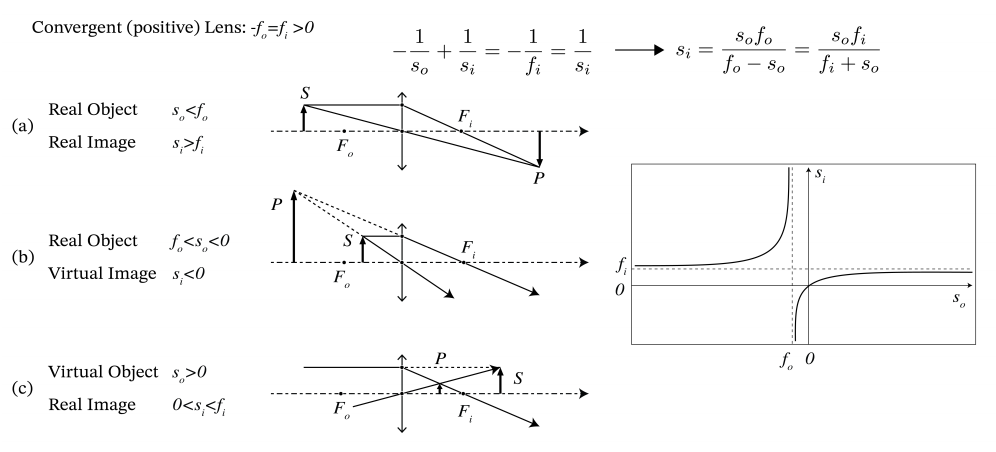
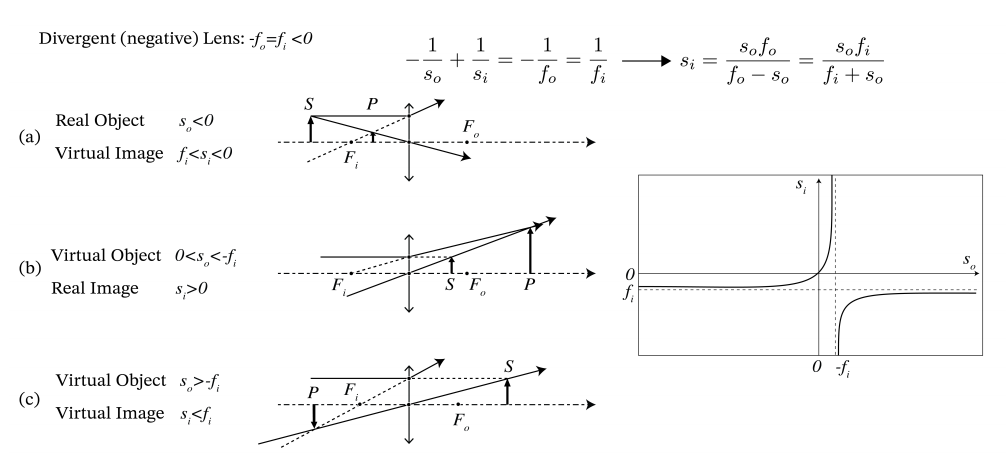
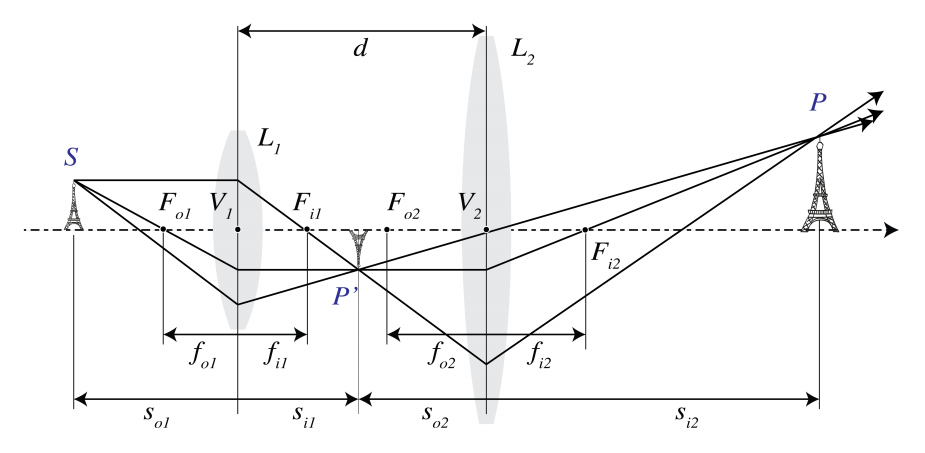
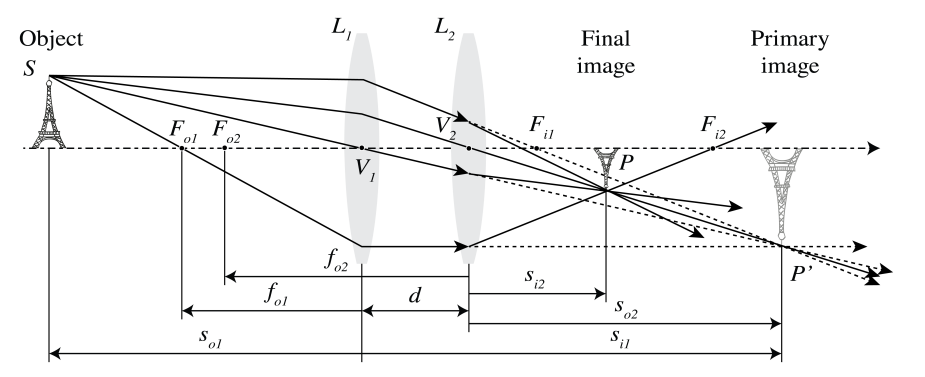
It is easy to express the z-coordinate si with respect to the coordinate system with origin at the vertex of L2 of the final image point, in the z-component so with respect to the origin at the vertex of lens L1 of the object point. We use the Lensmaker’s Formula for each lens while taking care that the proper local coordinate system is used in each case. The intermediate image P' due to lens L1 has z-coordinate s1i with respect to the coordinate system with origin at the vertex V1, which satisfies:
\dfrac{1}{s_{o}}+\dfrac{1}{s_{1i}}=\dfrac{1}{f_{1i}}. \nonumber
P' is object for lens L2 with z-coordinate with respect to the coordinate system with origin at V2 given by: s2o = s1i − d, where d is the distance between the lenses. Hence, with si = s2i the Lensmaker’s Formula for lens L2 implies:
-\dfrac{1}{s_{1i}-d}+\dfrac{1}{s_{i}}= \dfrac{1}{f_{2i}}. \nonumber
By solving (\PageIndex{51}) for s1i and substituting the result into (\PageIndex{52}), we find
s_{i}=\dfrac{-df_{1i} f_{2i}+ f_{2i}( f_{1i} -d)s_{o} }{ f_{1i}( f_{2i} -d) +( f_{1i}+ f_{2i} -d)s_{o} },two\space thin\space lenses. \nonumber
By taking the limit so → −∞, we obtain the z-coordinate fi of the image focal point of the two lenses, while si → ∞ gives the z-coordinate fo of the object focal point:
f_{i}=\dfrac{( f_{1i} -d) f_{2i} }{ f_{1i}+ f_{2i} -d}, \nonumber
f_{o}=-\dfrac{( f_{2i} -d) f_{1i} }{ f_{1i}+ f_{2i} -d}, \nonumber
Except when the refractive indices of the media before and after the lens are different, the object and image focal lengths of a thin lens are the same. However, as follows from the derived formula for an optical system with two lenses, the object and image focal lengths are in general different when there are several lenses.
By construction using the intermediate image, it is clear that the magnification of the two-lens system is the product of the magnifications of the two lenses:
M=M_{1}M_{2}. \nonumber
Remarks
1. When f1i + f2i = d the focal points are at infinity. Such a system is called telecentric.
2. In the limit where the lenses are very close together: d → 0, (\PageIndex{53}) becomes
-\dfrac{1}{s_{o}}+\dfrac{1}{s_{i}}= \dfrac{1}{f_{1i}}+ \dfrac{1}{f_{2i}}. \nonumber
The focal length fi of the system of two lenses in contact thus satisfies:
\dfrac{1}{f_{i}}=\dfrac{1}{f_{1i}}+\dfrac{1}{f_{2i}}. \nonumber
Two positive lenses in close contact enforce each other, i.e. the second positive lens makes the convergence of the first lens stronger. Similarly, two negative lenses in contact make a more strongly negative system. The same applies for more than two lenses in close contact.
3. Although for two lenses the image coordinate can still be expressed relatively easily in the object distance, for systems with more lenses finding the overall ray matrix and then using the image condition (\PageIndex{41}) is a much better strategy.
2.5.7 The Thick Lens
At the left of Figure \PageIndex{9} a thick lens is shown. The first focal point is defined as the point whose rays are refracted such that the emerging rays are parallel to the optical axis. By extending the incident and emerging rays by straight segments, the points of intersection are found to be on a curved surface, which close to the optical axis, that is in the paraxial approximation, is in good approximation a plane perpendicular to the optical axis. This plane is called the primary principal plane and its intersection with the optical axis is called the primary principal point H1. By considering incident rays which are parallel to the optical axis and therefore focused in the back focal point, the secondary principal plane and secondary principal point H2 are defined in a similar way (see the drawing at the right in Figure \PageIndex{9}). The principal planes need not be inside the lens. In particular for meniscus lenses, this is not the case. It can be seen from Figure 2.18 that the principal planes are images of each other, with unit magnification. Hence, if an object is placed in the primary principal plane (hypothetically if this plane is inside the lens), its image is in the secondary principal plane. The image is erect and has unit magnification.
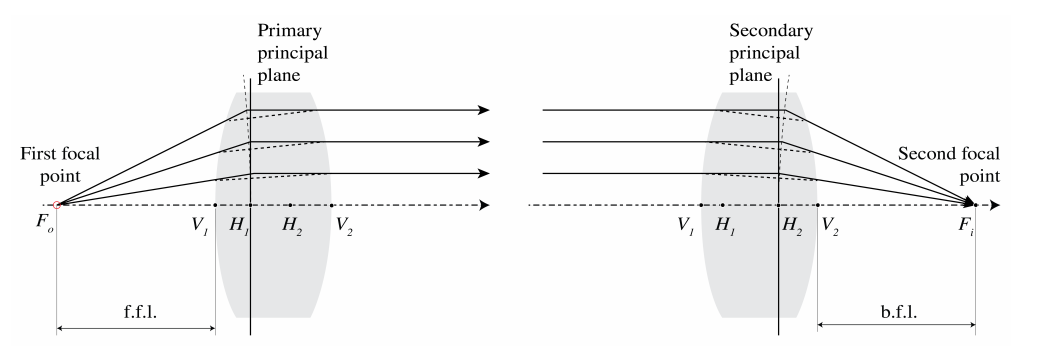
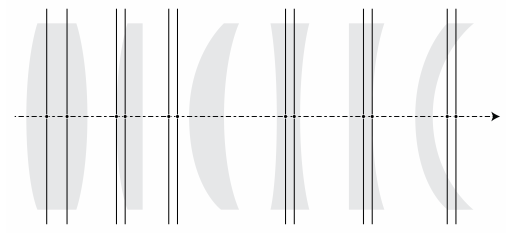
We recall the result (\PageIndex{32}) for the ray matrix between the planes through the front and back vertices V1, V2 of a thick lens with refractive index nl and thickness d:
M_{V_{1}V_{2}}=\begin{pmatrix} 1-\dfrac{d}{n_{l}}P_{2} & -P \\ \dfrac{d}{n_{l}} & 1-\dfrac{d}{n_{l}}P_{1} \end{pmatrix},thick\space lens, \nonumber
where
P_{1}=\dfrac{n_{l}-n_{m}}{R_{1}},P_{2}=\dfrac{n_{m}-n_{l}}{R_{2}}, \nonumber
and nm is the refractive index of the ambient medium, and
P=P_{1}+P_{2}-\dfrac{d}{n_{l}}P_{1}P_{2}. \nonumber
If h1 is the z-coordinate of the first principal point H1 with respect to the coordinate system with origin vertex V1, we have according to (\PageIndex{27}) for the ray matrix between the primary principal plane and the plane through vertex V1
M_{1}=\begin{pmatrix} 1 & 0 \\ \dfrac{h_{1}}{n_{m}} & 1\end{pmatrix}. \nonumber
Similarly, if h2 is the coordinate of the secondary principal point H2 with respect to the coordinate system with V2 as origin, the ray matrix between the plane through vertex V2 and the secondary principal plane is
M_{2}=\begin{pmatrix} 1 & 0 \\ \dfrac{h_{2}}{n_{m}} & 1\end{pmatrix}. \nonumber
The ray matrix between the two principle planes is then
M_{H_{1}H_{2}}=M_{2}M_{V_{1}V_{2}}M_{1}. \nonumber
The coordinates h1 and h2 can be found by imposing to the resulting matrix the imaging condition (\PageIndex{41}): C = 0 and the condition that the magnification should be unity: D = 1, which follows from (\PageIndex{42}). We omit the details and only give the resulting expressions here:
h_{1}=\dfrac{n_{m}}{n_{l}}\dfrac{P_{2}}{P}d, \nonumber
h_{2}=-\dfrac{n_{m}}{n_{l}}\dfrac{P_{1}}{P}d. \nonumber
Furthermore, (\PageIndex{64}) becomes
M_{H_{1}H_{2}}=\begin{pmatrix} 1 & -P \\ 0 & 1\end{pmatrix}. \nonumber
We see that the ray matrix between the principal planes is identical to the ray matrix of a thin lens (\PageIndex{35}). We therefore conclude that if the coordinates in object space are chosen with respect to the origin in the primary principal point H1, and the coordinates in image space are chosen with respect to the origin in the secondary principal point H2, the expressions for the first and second focal points and for the coordinates of the image point in terms of that of the object point are identical to that for a thin lens. An example of imaging by a thick lens is shown in Figure \PageIndex{11}.

2.5.8 Stops
An element such as the rim of a lens or a diaphragm which determines the set of rays that can contribute to the image, is called the aperture stop. An ordinary camera has a variable diaphragm.
The entrance pupil is the image of the aperture stop by all elements to the left of the aperture stop. If there are no lenses between object and aperture stop, the aperture stop itself is the entrance pupil. Similarly the exit pupil is the image of the aperture stop by all elements to the right of it. The entrance pupil determines for a given object the cone of rays that enters the optical system, while the cone of rays leaving and taking part in the image formation is determined by the exit pupil (see Figure \PageIndex{12}). Note that in constructing the entrance pupil as the image of the aperture stop by the lenses to the left of it, are propagating from the right to the left. Hence the aperture stop is a real object in this construction, while the entrance pupil can be a real or a virtual image. The rays used in constructing the exit pupil as the image of the aperture stop by the lenses following the stop are propagating from the left to the right. Hence also in this case the aperture stop is a real object while the exit pupil can be a real or a virtual image of the aperture stop.
For any object point, the chief ray is the ray in the cone that passes through the centre of the entrance pupil, and hence also through the centres of the aperture stop and the exit pupil. A marginal ray is the ray that for an object point on the optical axis passes through the rim of the entrance pupil (and hence also through the rims of the aperture stop and the exit pupil).
For a fixed diameter D of the exit pupil and given xo, the magnification of the system is according to (\PageIndex{50}) and (\PageIndex{48}) given by M = −xi/fi = fi/xo. It follows that when fi is increased, the magnification increases. A larger magnification means a lower energy density, hence a longer exposure time, i.e. the speed of the lens is reduced. Camera lenses are usually specified by two numbers: the focal length fi and the diameter D of the exit pupil. The f-number is the ratio of the focal length to this diameter:
f-number=\dfrac{f}{D}. \nonumber
For example, f-number= 2 means f = 2D. Since the exposure time is proportional to the square of the f-number, a lens with f-number 1.4 is twice as fast as a lens with f-number 2.
